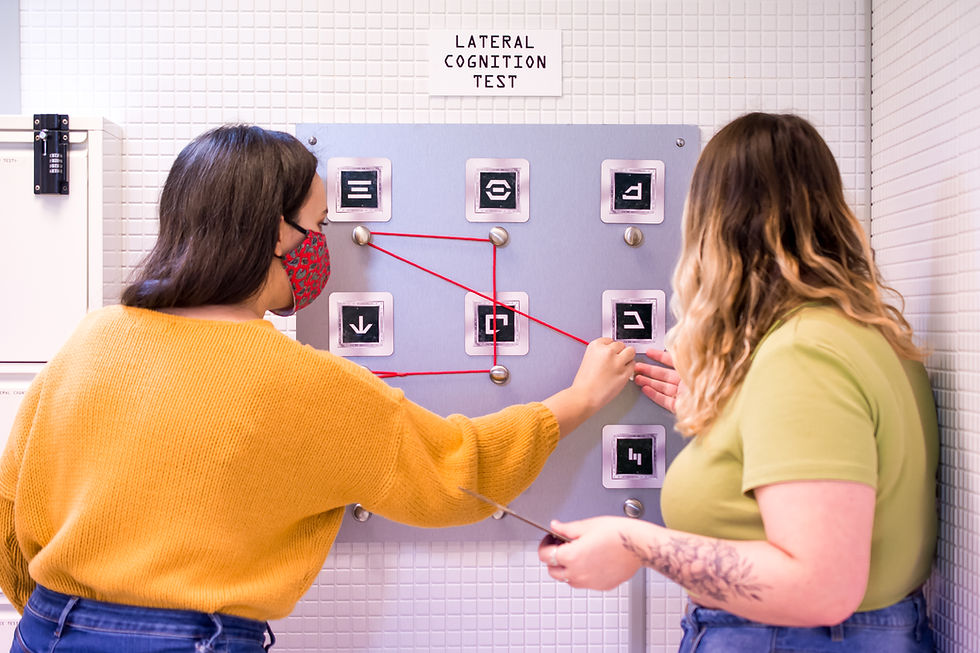DEFINE YOUR GENRE.
- dgoodman5
- Jun 14
- 4 min read
Updated: Jun 25
Why Clarity of Theme Equals Confidence in Booking

In today’s landscape of entertainment centres, escape room venues, and multi-attraction destinations, diversity is king. You’ll often find a thrilling 18+ horror experience sharing a hallway with a whimsical candy factory escape room for kids, or maybe a family friendly mini-golf centre that runs boozy adult nights. On paper, this seems like a win-win—appeal to everyone, and you cast the widest net possible.
But there’s a hidden cost to all that variety. You lose your identity.
Let’s break it down.
The First Impression Problem
Imagine you're a customer browsing the internet. You come across an ad for a dark, gritty horror experience. Your brain immediately associates that venue with mature entertainment. You’re unlikely to assume they also run child-friendly shows. And if you were looking for a fun family activity, you’ve probably already moved on.
Now flip it: someone sees a cheerful, cartoon-themed game and assumes this is a family-first business. They’re unlikely to guess that this same venue also hosts a terrifying 18+ scare attraction in the next room.
In the absence of clear messaging, the customer will define your genre for you. Often incorrectly.
Worse still, this isn’t just a digital problem. Even guests who’ve visited your venue in person may have only experienced one side of your offering. That narrow lens becomes their entire impression of your business.
So, what’s the solution?
Separate to Succeed
If you’re already offering a broad mix of attractions, it’s not too late. But you do need to put in the work to organise and market them clearly.
1. Categorise by Genre
Start by taking stock. Which attractions are family-friendly? Which are for adults only? Which are scare-focused, competitive, casual, educational, etc.? Once you’ve divided your portfolio into genre-based categories, you can start targeting the right audiences more effectively.
2. Segment Your Web Presence
Don't funnel every guest to the same generic homepage. Create distinct landing pages, or even separate websites or subdomains for each genre. These should look and feel completely different.
For example:
Your horror experience page should be dark, edgy, intense.
Your family fun experience page should be bright, playful, easy-going.
Even if they’re under the same roof, these should feel like different brands. You can still link between them if needed, but make sure the vibe is unmistakable at first glance.
3. Match Your Advertising
Genre-first thinking doesn’t stop at your website. It’s equally critical, if not more-so, in your advertising.
An ad for a scary 18+ game should not lead to a homepage full of bowling pins and birthday packages. That disconnect is how customers bounce.
Instead:
A kid-focused ad should land on a lighthearted, colorful page with age-appropriate language and offers.
An adult-focused ad should land on a page that oozes after-dark energy, with bold messaging and tone to match.
This makes your messaging clear, direct, and trustworthy.
Be Confident in Your Demographic
You cannot be all things to all people at once. When you try, you create confusion, dilute your message, and reduce the perceived value of your offering.
For example:
If you run a family-friendly escape game that transforms into a scary 18+ experience once a month, market these events separately.
Don’t mash them into one ad or web page. You’ll alienate both audiences in the process.
Also, consider this: when you quickly flip your experience from kid-safe to horror-ready overnight, savvy customers may question the depth and quality of either version. If it only took a few hours to “go scary,” how scary can it really be? What quality is really being reached? What ticket price does this justify?
Stick to your lane. Define the tone. Commit to the demographic.
People trust and value brands that know what they are.
Shout It Loud
If your venue is an adult experience—own it. Don’t tiptoe around it with small print like “family groups welcome.”
Going all in gives you creative freedom:
Mature themes
Late-night events
Exclusive marketing channels
Likewise, if your experience is designed for children, go full throttle on the fun, the color, and the accessibility. Adults aren’t going to pay top dollar to crawl around a foam pit (even if it has been marketed as an adults-only night) unless they’re there for their kids. So lean into that identity.
The more confidently you express your genre, the more confidently your customers will book.
Final Thought: Genre Comes First
Even if all your attractions are technically the same format, eg. immersive theatre, the genre is what determines who they’re for. And that determines how you should market them.
So remember:
Customers don’t read between the lines.
Mixed messaging leads to mistrust.
Confidence in your brand tone breeds confidence in your product.
Define your genre. Declare it proudly. And your audience will thank you for knowing exactly what they came for.
DESIGNING IMMERSIVE.
It's complicated, intricate and specialist. Koncept has it mastered.
Koncept are specialists in writing and designing immersive attractions that stand out. With a portfolio of award-winning productions, Koncept has a proven track record of transforming ideas into fully realized, expertly written experiences that customers will pay to be immersed in.
_edited_p.png)




Comments